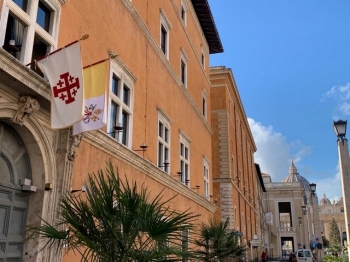What does it mean for the Order to be “a Central Body of the Church”?

With the approval of the new Constitution of the Equestrian Order of the Holy Sepulchre of Jerusalem, which makes explicit the principle that our Institution is a "Central Body of the Church", this aspect needs some explanation. In a separate article, S. E. Mgr. Tommaso Caputo, Assessor of the Order, who contributed to the drafting of the Constitution, explains clearly what this means.
Here, I would simply like to summarise the aspects that relate to what constitutes a Central Body of the Church.
The first fundamental element which creates a Body lies in the consent of the Authority which establishes the Institution itself, which, for this reason, assumes a legal “status”.
The second element is found in the objectives set by the Constituent Authority itself and assumed by it. This means that the Body is recognised as promoting the public interest, and that is why it is recognised as having a “public” status.
The third element lies in the fact that the Body is competent to carry out acts and transactions to achieve the objectives set for it.
This is why the Institution must have an identified seat or office, a Statute and Rules which determine its life.
If we translate all this in terms adapted to our Institution, we can say that our Order is a central Body of the Church insofar as it is established by the Supreme Authority of the Church, the Pope, who recognises its public status, with the intention of responding permanently and adapted to the needs of the Church in the Holy Land and in collaboration with the Latin Patriarchate of Jerusalem, for the support of pastoral, liturgical, educational, and social life in the Land of Jesus; therefore, to achieve these objectives, the Order is able to perform the material acts necessary for the achievement of said objectives. Its head office is in Rome, and it is endowed with the legal instruments which govern its life.
The Apostolic See has intrinsically linked to our particular Institution, as a specific condition, the Christian formation of its members, because the Order takes its name and its inspiration from this Sepulchre which testified to the presence of the dead Jesus and saw his resurrection.
It is therefore not just any entity, but an Institution that is rooted in the mystery of the Redemption which is intended for the salvation of peoples of all times and all places. The Church therefore wants this Land not simply to be a sacred archaeological place but a living one, thanks to the presence of Christian communities, the resident and pilgrim ones, who truly give it life; in this, we are honoured not only to participate, but also to contribute to the mission of Christ which the Church and the Holy Father have entrusted to us. It is here where the source of this “noble Institution” is found, in the attire of the Dames and Knights of the Holy Sepulchre of Jerusalem.
Cardinal Fernando Filoni
(January 2021)



